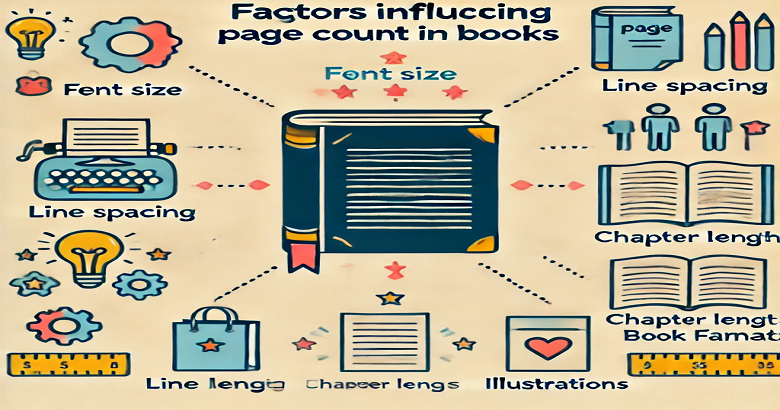Publishing a book is a dream for many writers. However, one question often looms: “How many pages do you need to publish a book?” The answer is not straightforward, as it depends on various factors such as genre, audience, and publishing format. In this comprehensive guide, we’ll explore these factors and provide insights to help you determine the ideal length for your book.
What is a Book Length?
Before delving into specifics, it’s essential to understand that book-length is typically measured in word count rather than page count. The reason for this is simple: page count can vary significantly depending on font size, type, margins, and formatting. Word count, however, provides a more consistent measure.
Word Count Standards by Genre
Different genres have different expectations when it comes to word count. Here are some general guidelines:
- Novels: Generally range from 70,000 to 100,000 words. Literary fiction might lean towards the higher end, while genre fiction, like romance or thrillers, can sometimes be shorter.
- Novellas: Typically range from 20,000 to 50,000 words.
- Short Stories: Usually fall between 1,000 and 7,500 words.
- Children’s Books: Vary widely, from 500 words for picture books to 20,000 words for middle-grade novels.
- Young Adult (YA) Novels: Usually range from 50,000 to 80,000 words.
- Non-Fiction: Can vary significantly based on the topic but often falls between 50,000 and 80,000 words.
Factors Influencing Page Count
 Formatting Choices
Formatting Choices
Your formatting choices will have a significant impact on the final page count of your book. Here are some key factors to consider:
- Font Size and Type: Larger and more decorative fonts can increase page count. Standard choices like Times New Roman or Arial at 12-point size are common in the industry.
- Margins: Wider margins result in fewer words per page, increasing the total page count.
- Line Spacing: Single spacing will fit more text on a page than double spacing.
- Trim Size: This refers to the dimensions of the book. Standard trim sizes vary by genre and market.
Genre and Audience Expectations
The expectations of your target audience and the norms of your genre play a crucial role in determining the length of your book. For example, epic fantasy novels often exceed 100,000 words, while cozy mysteries might be closer to 60,000 words. Understanding these norms can help you avoid books that feel too short or too long for your readers.
Publishing Format
The format in which you intend to publish your book—print, e-book, or audiobook—can also influence your page count considerations. E-books, for instance, can be more flexible with length because they don’t have the physical constraints of print books. However, print books must adhere to certain page counts to ensure they are physically practical and cost-effective.
Calculating Page Count
While word count gives you a general idea of your book’s length, you might want to estimate the number of pages it will translate into. Here’s a rough guide to help you:
- For Novels: Typically, one page in a standard manuscript format (double-spaced, 12-point Times New Roman, 1-inch margins) equals 250-300 words. Thus, a 70,000-word novel would be approximately 230-280 pages.
- For Non-Fiction: Non-fiction books often have more varied formatting, including headings, subheadings, and illustrations. However, a similar estimate of 250-300 words per page can be used as a baseline.
Tools and Software
There are various tools and software available that can help you estimate your book’s page count. Programs like Microsoft Word and Scrivener have built-in word count features, and some self-publishing platforms offer page count calculators based on word count and formatting choices.
Editing and Its Impact on Length
Editing is a crucial phase in book publishing and can significantly impact your book’s length. Here’s how:
Developmental Editing
This stage involves evaluating the overall structure and content of your book. It might lead to adding new chapters or removing redundant sections, thereby affecting the total word count.
Line Editing and Copyediting
These stages focus on refining your prose and correcting grammatical errors. While they might not drastically change the word count, they can influence the readability and flow of your text, indirectly affecting how long it feels to the reader.
Proofreading
This is the final editing stage, where the focus is catching any remaining errors. It typically has a minimal impact on word count but is essential for producing a polished manuscript.
The Role of Self-Publishing and Traditional Publishing
 The path you choose—self-publishing or traditional publishing—can also influence the ideal length of your book. Each route has its own set of expectations and standards.
The path you choose—self-publishing or traditional publishing—can also influence the ideal length of your book. Each route has its own set of expectations and standards.
Traditional Publishing
In traditional publishing, agents and publishers often have specific guidelines for manuscript length based on genre and market trends. These guidelines are essential because they align with industry standards and reader expectations. For instance:
- Debut Authors: Publishers are often more conservative with debut authors, preferring manuscripts within standard word count ranges to minimize financial risk.
- Established Authors: Those with a proven track record may have more leeway to write longer or shorter books, as their audience is likelier to trust their storytelling.
Self-Publishing
Self-publishing offers more flexibility regarding book length. However, this freedom comes with the responsibility of ensuring that your book meets reader expectations:
- Flexibility: You can publish shorter works like novellas or collections of short stories, which might be harder to sell to traditional publishers.
- Niche Markets: Self-publishing allows you to target niche markets with specific preferences for book-length and content.
- Production Costs: Remember that print-on-demand services charge based on page count, so longer books will cost more to produce and potentially more for readers to purchase.
Practical Tips for Determining Your Book’s Length
Now that we’ve explored the various factors influencing book-length, here are some practical tips to help you determine the ideal length for your book:
Research Your Genre
Spend time reading books in your genre to understand the typical length. Pay attention to bestsellers and newly published works, as they often set current trends.
Know Your Audience
Consider who your readers are and what they expect. For example, young adult readers might prefer faster-paced, shorter books, while adult fantasy readers might enjoy more detailed, longer narratives.
Outline Your Story
Create a detailed outline before you start writing. This can help you estimate the length of your book and ensure that your story has a clear beginning, middle, and end without unnecessary filler.
Write First, Edit Later
Don’t get bogged down by word count during the initial writing phase. Focus on getting your story down on paper. You can always trim or expand during the editing process.
Use Beta Readers
Beta readers can provide valuable feedback on pacing and length. They can tell you if parts of your book feel too slow or rushed, helping you make adjustments.
Consult Professionals
If unsure, consider consulting with a professional editor or literary agent. They can provide guidance based on their experience and knowledge of the market.
Conclusion
Determining the ideal length for your book involves balancing several factors, including genre conventions, audience expectations, and publishing format. While there are general guidelines for word counts across different genres, the most important thing is that your book feels complete and satisfying to your readers.
Remember, every story is unique. Some stories need more space to unfold, while others are best told succinctly. Focus on telling your story well; the right length will follow naturally.
By understanding the norms and leveraging the flexibility of modern publishing options, you can find the sweet spot for your book’s length and bring your vision to life. Happy writing!
Frequently Asked Questions
What is the average length of a novel?
- The average length of a novel typically ranges between 70,000 and 90,000 words, which is about 250 to 350 pages, depending on the formatting and font size.
Does genre affect the ideal page count of a book?
- Yes, different genres have different expectations for length. For example, fantasy novels often exceed 100,000 words, while romance novels might be closer to 50,000 to 60,000 words.
How do page margins and font size influence page count?
- Larger margins and larger font sizes will increase the page count of your book. Conversely, smaller margins and font sizes will reduce the number of pages.
What is the typical page count for a non-fiction book?
- Non-fiction books often range from 50,000 to 75,000 words, translating to about 200 to 300 pages, but this can vary widely depending on the subject matter and depth.
Is there a minimum page count required to publish a book?
- There is no strict minimum, but most publishers prefer books to be at least 100 pages to be marketable. Shorter works might be considered novellas or pamphlets.



